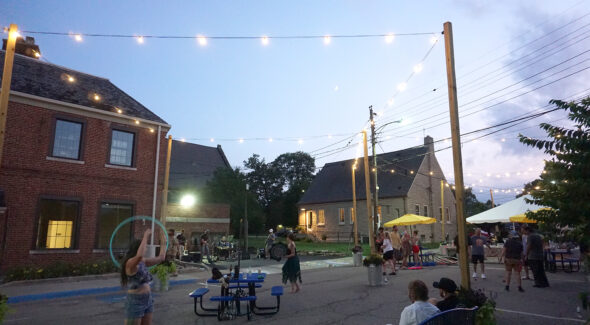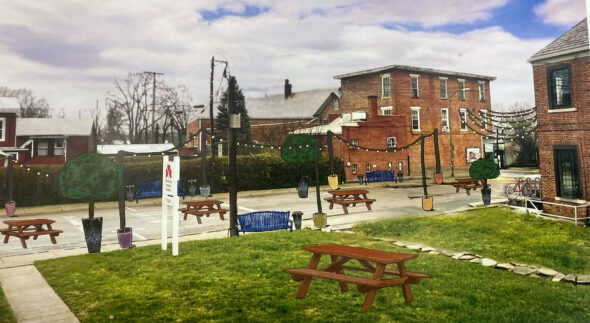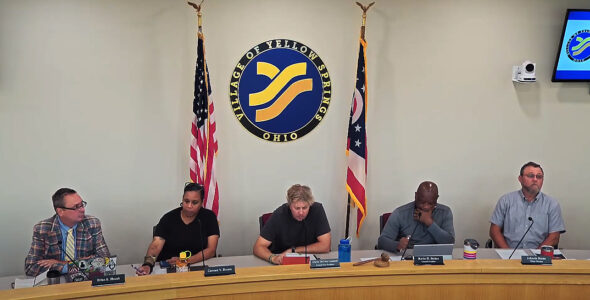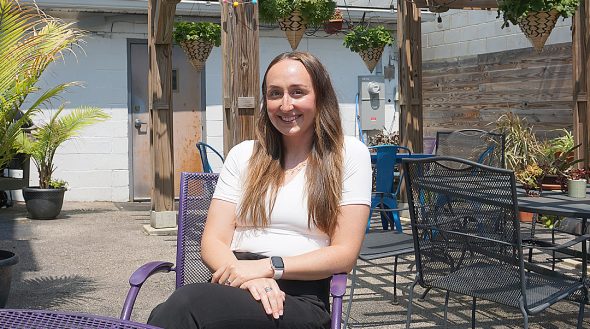
Since closing to vehicle traffic in June, Short Street has seen its fair share of planned and impromptu gatherings of villagers and visitors. (Photo by Reilly Dixon)
Village Council considers the fate of Short Street
- Published: September 8, 2025
A small road in downtown Yellow Springs continues to make big waves in the community.
In the months since its closure to vehicle traffic earlier this summer, Short Street’s pedestrian-oriented space has morphed into a place for villagers and visitors to gather, eat and occasionally dance.
It has also proven to be somewhat divisive — some local residents relish the newly installed picnic benches and occasional music performances, while others claim it’s led to traffic problems and a decline in business sales in downtown shops.
On Tuesday, Sept. 2, at their most recent regular meeting, Village Council members considered these pros and cons of the ongoing road closure, when Village Manager Johnnie Burns gave a brief presentation about the changes to Short Street, as well as changes still to come.
“This started as a pilot project and it’s still a pilot project,” Burns said. “We’re learning as we go.”
When Burns announced the closure of Short Street at a June Council meeting ahead of the June 14 Street Fair, the outlined plan was then to reopen the road to vehicular traffic following the Oct. 11 Street Fair.
Click here to read the Village of Yellow Springs’ FAQ regarding the Short Street pilot project.
Click here to provide feedback or ideas regarding the design of the pilot project.
His presentation at Tuesday’s Council meeting, however, indicated that Short Street may be closed to cars in perpetuity.
“The pilot has demonstrated Short Street’s potential as a vibrant, community-focused public space,” his presentation read. “With [Council’s] support, we recommend permanently closing Short Street and continuing enhancements to create a lasting, engaging space for residents and visitors.”
Though this recommendation was expressed in the last of Burns’ slides, the manager didn’t vocalize the point to Council, nor did the group take any formal action on the matter; Burns and Council members agreed to revisit the possibility of permanently closing Short Street at the group’s Oct. 20 regular Council meeting — just over a week following Fall Street Fair.
In the meantime, local residents can still weigh in on the ongoing pilot and share their suggestions, praise or misgivings with the Village and other project stakeholders.

The original rendering of the Short Street pilot project. (Rendering courtesy of the Village of Yellow Springs)
Chamber of Commerce Executive Director Phillip O’Rourke echoed Burns’ sentiments and reiterated that the overall look of the community space, future events and “vision” of Short Street are all fluid and will reflect community input.
“This must be something that is happening with the community, with downtown businesses, not something that is happening to everybody,” O’Rourke told Council.
To that end, O’Rourke encouraged people to go to http://www.keepitvibrant.org to provide project feedback or design ideas before Monday, Sept. 15, when the digital window for input closes.
Burns’ presentation stated that feedback from the above survey will inform the Village’s potential improvements to the street, such as resurfacing with alternative materials, landscaping, additional shade options and decorative bollards to replace the concrete barriers.

A DJ batle between Shane Creepingbear (left) and Basim Blunt brought hundreds of locals out on Sunday, Aug. 31, to boogie in the street. (Photo by Reilly Dixon)
Since June, Short Street has been the site of a number of community events and music performances. In August, Little Art Theatre’s marquee unveiling celebration brought an estimated 400 people to mark the occasion. Attendance for that event may have been surpassed this past Sunday, when a “DJ battle” drew hundreds of local dancers and revelers to the community space.
Also throughout August, the YS Community Foundation and Mad River Theater Works partnered together to bring weekly plein air music performances to Short Street; O’Rourke said on Tuesday that those performances will continue through September, now on Wednesday nights instead of Thursday nights to avoid scheduling overlap with other downtown music venues.
However, some community members remain dismayed by the pilot project and suggest its drawbacks outweigh any benefit to the downtown business district.
In a letter to Council, Ohio Silver Co. owner Marcia Wallgren said her business — located directly across Xenia Avenue from the Short Street intersection — has suffered marked losses in profits since the road’s closure. Wallgren said she’s clocked only a fifth of her normal business on Saturdays since Short Street lost its parking spaces.
As Burns noted in his presentation, the lost 14 parking spaces on Short Street have mostly been recouped on adjacent streets. Seven new standard parking spaces were created along Walnut Street, and two handicap accessible spots were established on Xenia Avenue in front of US Bank — amounting to a loss of five spaces owing to Short Street’s closure.
In local online discussion boards and in recent letters to the editor, other detractors of the pilot project have raised a variety of concerns: a perceived increase in downtown traffic congestion on Xenia Avenue, an uptick in cars reportedly cutting through the parking lot behind Tom’s Market, an apparently unhoused population using Short Street as an occasional gathering space, and more.

Short Street was jam packed on Friday night, Aug. 15, for the unveiling of Little Art Theatre’s new marquee — an LED homage to the theater’s aesthetics of yesteryear and a downtown beacon for the days ahead. Staffers and board members of the 96-year-old theater told the News that the lighting of the new marquee is the first of many upcoming improvements ahead of Little Art’s centennial in 2029. (Photo by Reilly Dixon)
Per Council’s request, Village staff will spend the next few weeks amassing additional data points about Short Street — such as costs, plans, impressions from downtown businesses and survey results — ahead of the Oct. 20 meeting, when the group will likely determine the future of the road closure.
In other Council business, Sept. 2—
Stipend hike approved
By a vote of 4–0 — member Trish Gustafson was absent — Council approved an ordinance that raised the monthly stipend for Council members to $1,000 per month.
The raise will not benefit those Council members who voted on the matter, but rather the newly elected Council members from the upcoming Nov. 4 general election, and then the winners of future contests for Council seats.
As a memo from Council member Carmen Brown noted, the raise is meant to be added compensation that allows Council members to be eligible for both state retirement service and healthcare credits.
“This change is being proposed to ensure that serving in local government is accessible and fair, while also providing credit towards long-term benefits to those who dedicate their time to public service,” the memo stated.
Council last voted for a pay raise in 2013, when the Council stipend went from $4,000 per year to $7,200 a year. Before that, in 2009, it went from $2,100 to $4,000 per year.

Present for the Sept. 2 Village Council meeting were, from left, Brian Housh, Carmen Brown, Gavin DeVore Leonard, Kevin Stokes and Village Manager Johnnie Burns. Absent was Council member Trish Gustafson. (Video still)
Village seeks sidewalk grant
By a unanimous vote, Council approved a resolution that authorizes Manager Burns to submit a grant application to the Ohio Public Works Commission, or OWPC, requesting $452,047 to help cover the infrastructure costs associated with one day building more sidewalks along Yellow Springs-Fairfield Road, between Ridgecrest Drive and the bike path.
According to Burns, before the Village seeks out funds from the Ohio Department of Transportation’s Systemic Safety Program to begin the work of building new walkways, the Village must first improve the stormwater infrastructure along Fairfield.
Burns said that the estimated cost of the initial stormwater improvements is $536,047; should the Village be awarded the OWPC grant, the Village will provide a local match of $84,075 from the municipal storm and sewer fund.
Beyond paving the way for a future sidewalk, Burns said the stormwater improvements will take care of occasional flooding and icy conditions that sometimes occur on Fairfield near DeWine Pond.

Village native and 2011 YSHS graduate Elyse Giardullo was hired last summer as village lead; she’s now assistant village manager. (Photo by Reilly Dixon)
Project Lead now Asst. Manager
Voting 4–0, Council approved a resolution that authorizes changing the title of a municipal position: the village lead is now the assistant village manager.
“Adopting this title change supports the efficient administration of Village operations and reflects the evolving scope of the project lead position,” Burns wrote to Council ahead of Tuesday’s meeting.
Yellow Springs resident Elyse Giardullo was hired last June as the Village’s first-ever project lead, and her work in the year since has included strategic planning, compiling municipal data, leading special meetings and filling in for Burns at a Council meeting.
In addition to the new title, changes to the position include the added duties of planning, scheduling and coordinating Village operations, including the oversight of human resources and communications; developing and enforcing departmental rules, regulations, work methods and procedures; and overseeing the hiring, training, supervision and performance evaluation of direct reports.
CRA work begins
Council approved a resolution to authorize Burns and Village Planning and Economic Development Director Meg Leatherman to begin the work of developing a community reinvestment area, or CRA.
As the News reported last week, a CRA is a property tax reduction tool overseen by the Ohio Department of Development and administered by county and local governments.
CRAs — areas as big or small as a municipality chooses — can abate real property taxes on the county auditor’s appraised value of structural improvements, renovations or new constructions made to a parcel. The tax abatement ultimately reduces the property owner’s overall development costs in exchange for their physical contribution.
While the legislation Council approved on Tuesday does not establish a CRA in Yellow Springs, it sets into motion the necessary first steps, namely authorizing staff to undertake a housing survey.
“This is a preliminary step,” Village Solicitor Amy Blankenship told Council. “We will bring back the enabling legislation.”
Provided the state-mandated housing survey necessary to establish one or several CRAs in town is approved, Council will be able to determine the scope and intent of the Village’s CRA plan. For instance, Council members could opt to incentivize affordable housing options and encourage future development in certain parts of town over others.
Council members voted 3–0 on the resolution, with Council President Kevin Stokes recusing himself, owing to his professional ties to Antioch College — one of the areas in town that may be affected by a CRA plan.
The next Village Council meeting will be held Monday, Sept. 15, at 6 p.m. in Council Chambers in the John Bryan Community Center.
The Yellow Springs News encourages respectful discussion of this article.
You must login to post a comment.
Don't have a login? Register for a free YSNews.com account.













No comments yet for this article.